Neuroscience Lecture 14 - Primary Visual Cortex and Cortical Modules
1/34
There's no tags or description
Looks like no tags are added yet.
Name | Mastery | Learn | Test | Matching | Spaced |
|---|
No study sessions yet.
35 Terms
How is this visual information processed?
A. How do you recognize this as a face?
1. Visual processing occurs in stages.
2. Retina processing followed by V1 processing followed by V2, V3 processing....
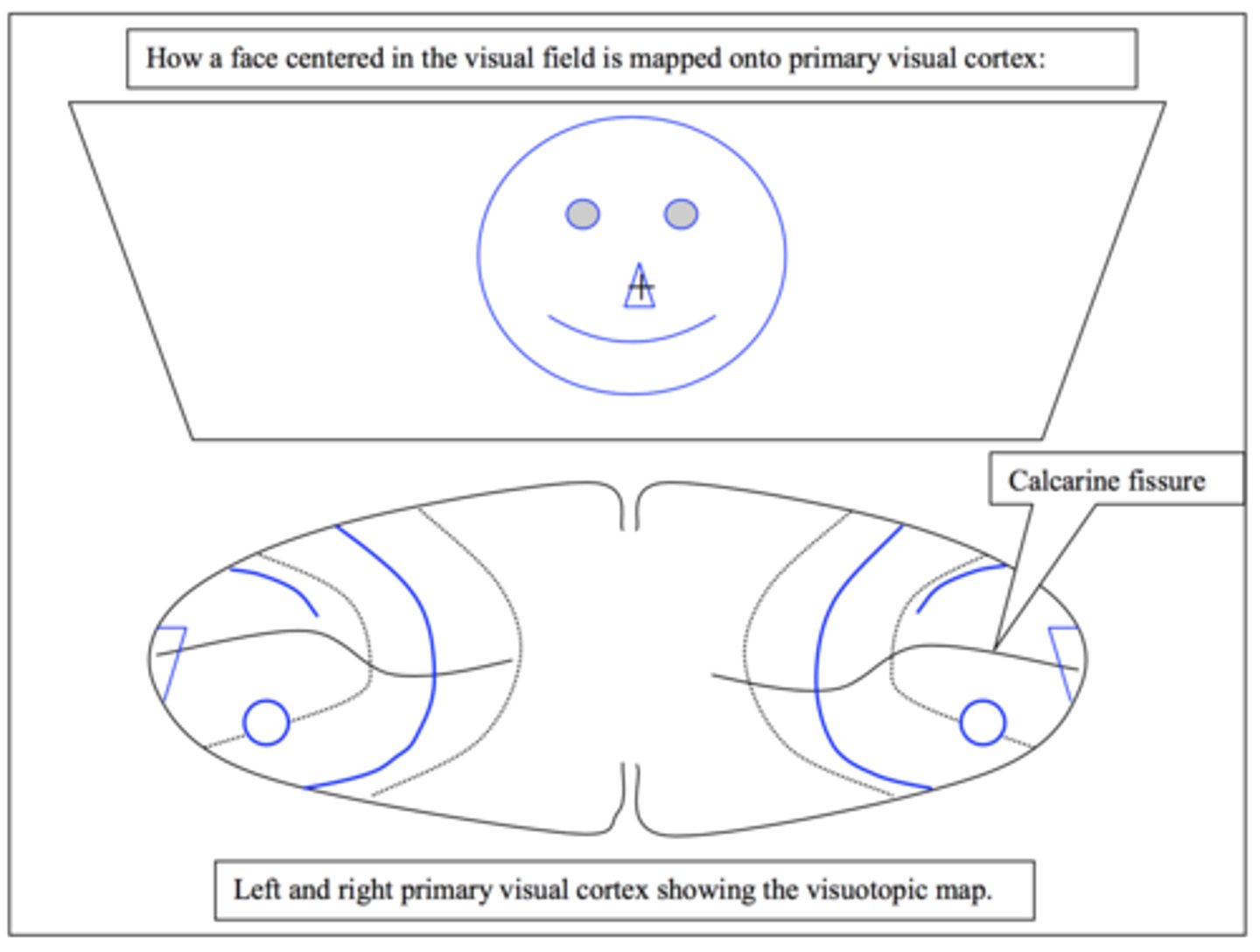
The diagram shows both the visuotopic/retinotopic map in V1 and how it is parceled into cortical modules:
B. In V1 (primary visual cortex) how is information analyzed?
1. The visual field is broken up into approximately 1000 parts and information from each
location is analyzed by neurons in ~ 1000 different cortical modules.
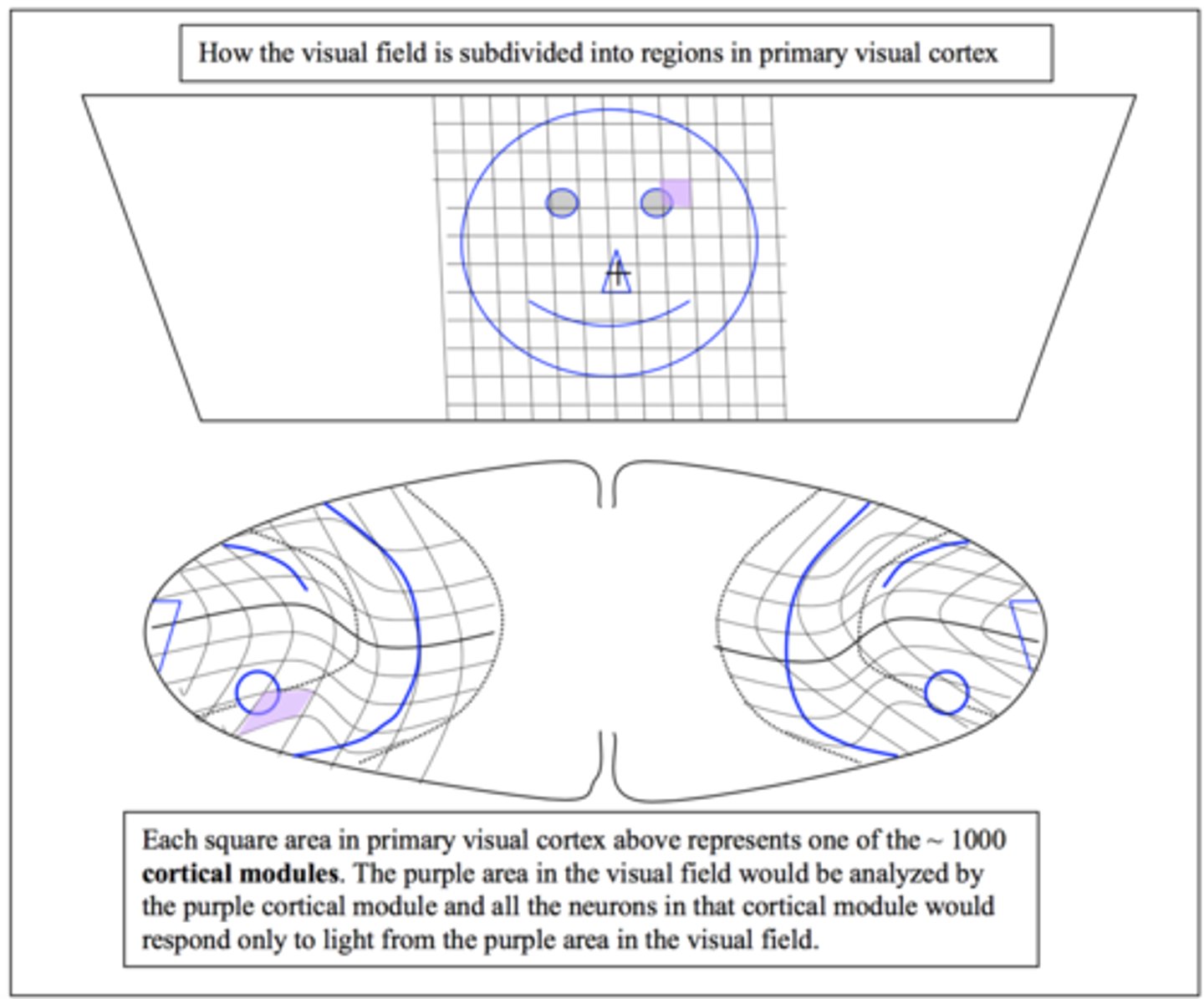
Cortical modules
Cortical modules are hypothetical constructs but they have a physiological basis. Conceptually, each cortical module in primary visual cortex can be thought of as a computer containing all of the neural machinery needed for the initial analysis of the visual information in a single location in the visual field. Different neurons in each cortical module analyze different aspects of a visual stimulus. Some (e.g., in "blobs") analyze the color of an object, while other neurons (e.g., those in "Orientation Columns") analyze the shape or form of an object.
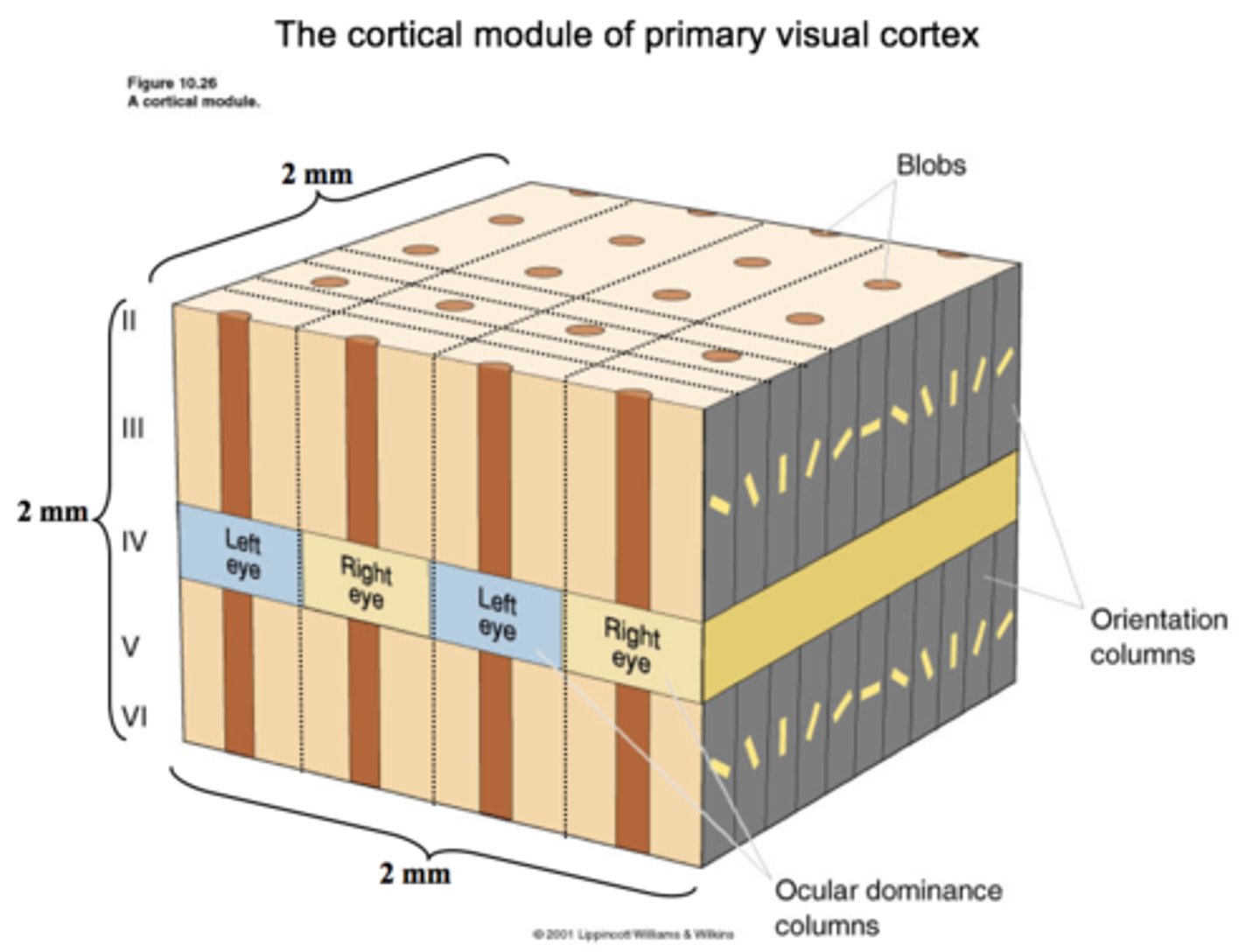
Some features of cortical modules
1. There are about 1000 of them in primary visual cortex with adjacent cortical modules analyzing inputs from adjacent locations in the visual field (forming a visuotopic "map" of the world onto primary visual cortex).
2. They are cubes (2 mm x 2 mm x 2 mm).
3. There are about 300,000 neurons in each cortical module.
4. A cortical module contains 4 ocular dominance columns (actually shaped like slabs).
5. A cortical module has 36 orientation columns (also shaped like slabs).
6. A cortical module has 16 blobs (ironically, these are shaped like columns).
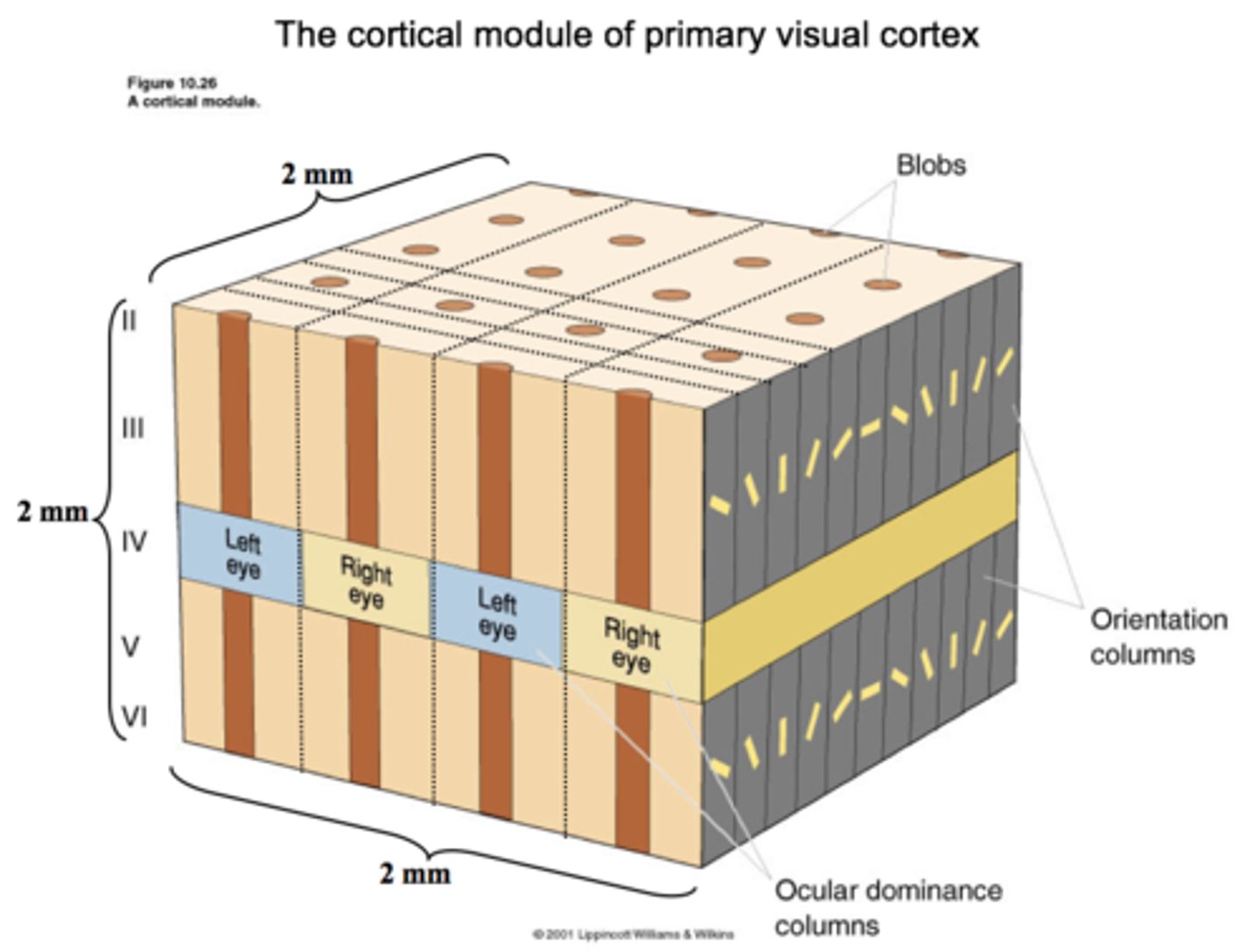
How many cortical modules are there in primary visual cortex?
There are about 1000 of them in primary visual cortex with adjacent cortical modules analyzing inputs from adjacent locations in the visual field (forming a visuotopic "map" of the world onto primary visual cortex).
How big are the cortical modules and what shape are they?
They are cubes (2 mm x 2 mm x 2 mm).
How many neurons are there in each cortical module?
There are about 300,000 neurons in each cortical module.
How many ocular dominance columns are there in each cortical module and what are they shaped like?
A cortical module contains 4 ocular dominance columns (actually shaped like slabs).
How many orientation columns are there in a cortical module and what are they shaped like?
A cortical module has 36 orientation columns (also shaped like slabs).
How many blobs are there in a cortical module and what are they shaped like?
A cortical module has 16 blobs (ironically, these are shaped like columns).
Figure 10.26 shows a diagrammed example of a cortical module. Neurons in a single cortical module all respond to visual input from the same particular location in the visual field. That is, their receptive fields all have similar locations.
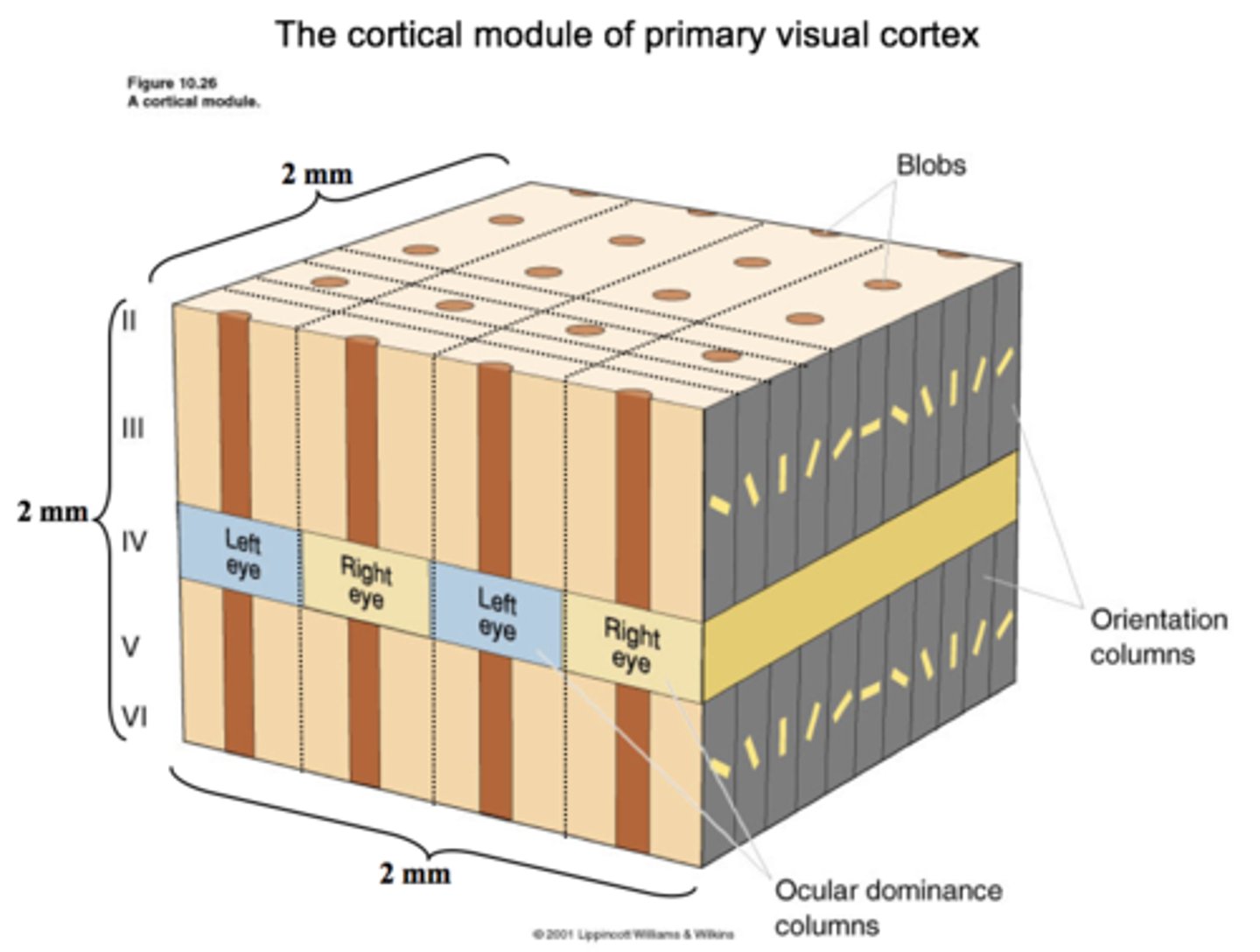
Neurons in a single cortical module all respond to what and from where?
Neurons in a single cortical module all respond to visual input from the same particular location in the visual field.
Understand Figure 10.26
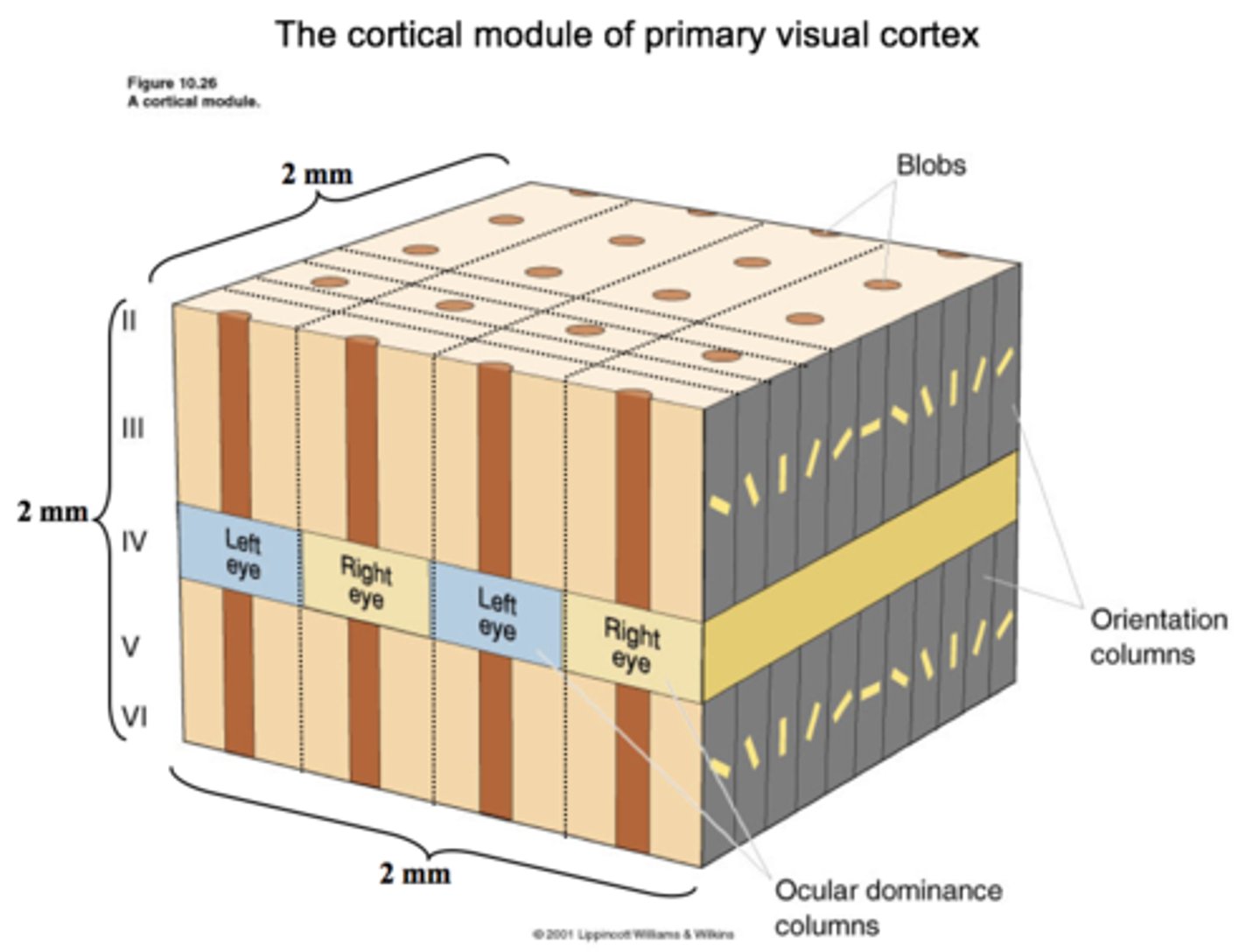
What defines an ocular dominance column?
What defines an ocular dominance column is that all the neurons in it respond primarily and preferentially to input from the same eye. Neurons in layer 4C respond to input from only one eye (one hemiretina), while the neurons in the layers above and below are driven by input from both eyes (i.e., the ipsilateral temporal hemiretina and contralateral nasal hemiretina), with the input from one hemiretina having a dominant influence.
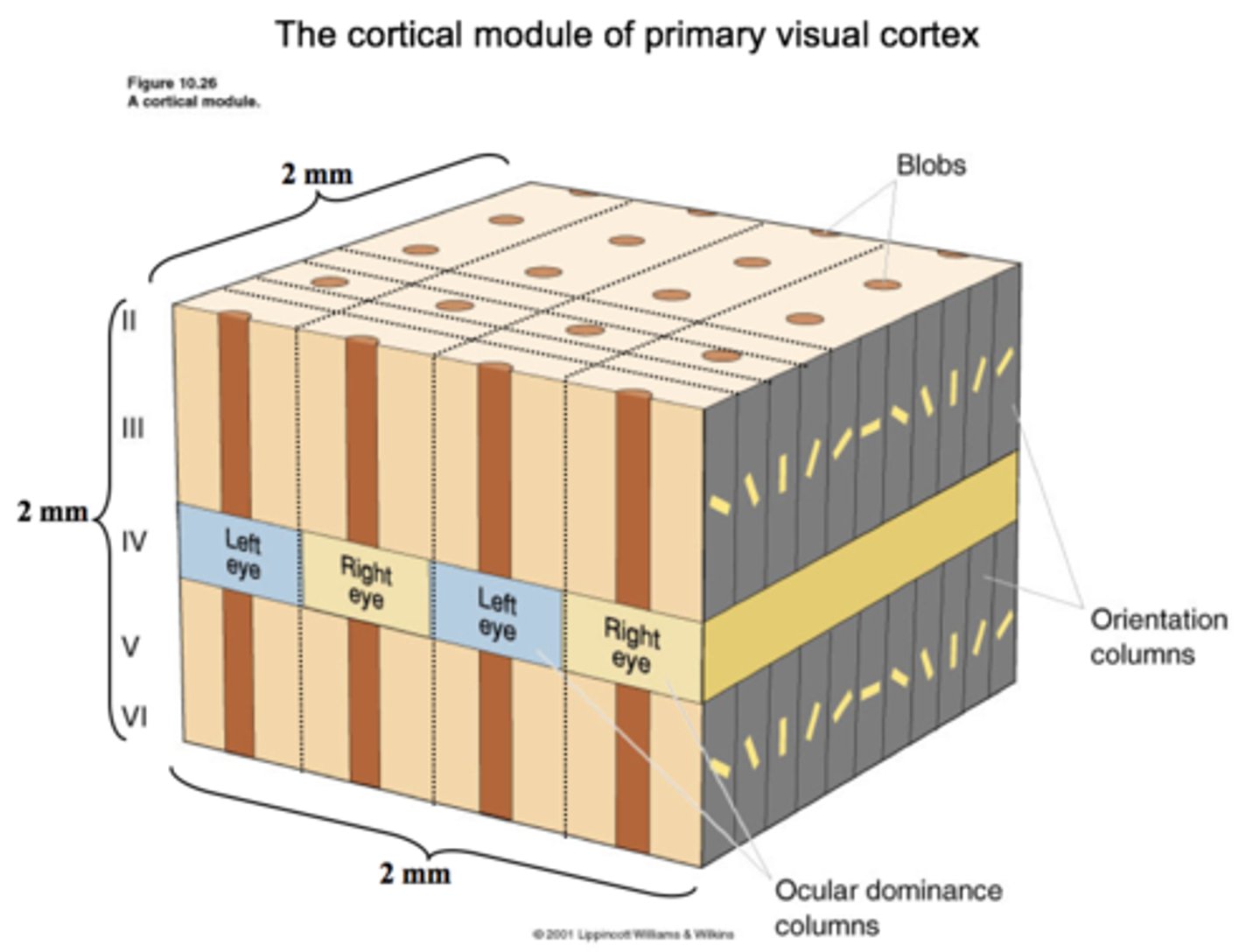
Neurons in layer 4C respond to what?
Neurons in layer 4C respond to input from only one eye (one hemiretina)
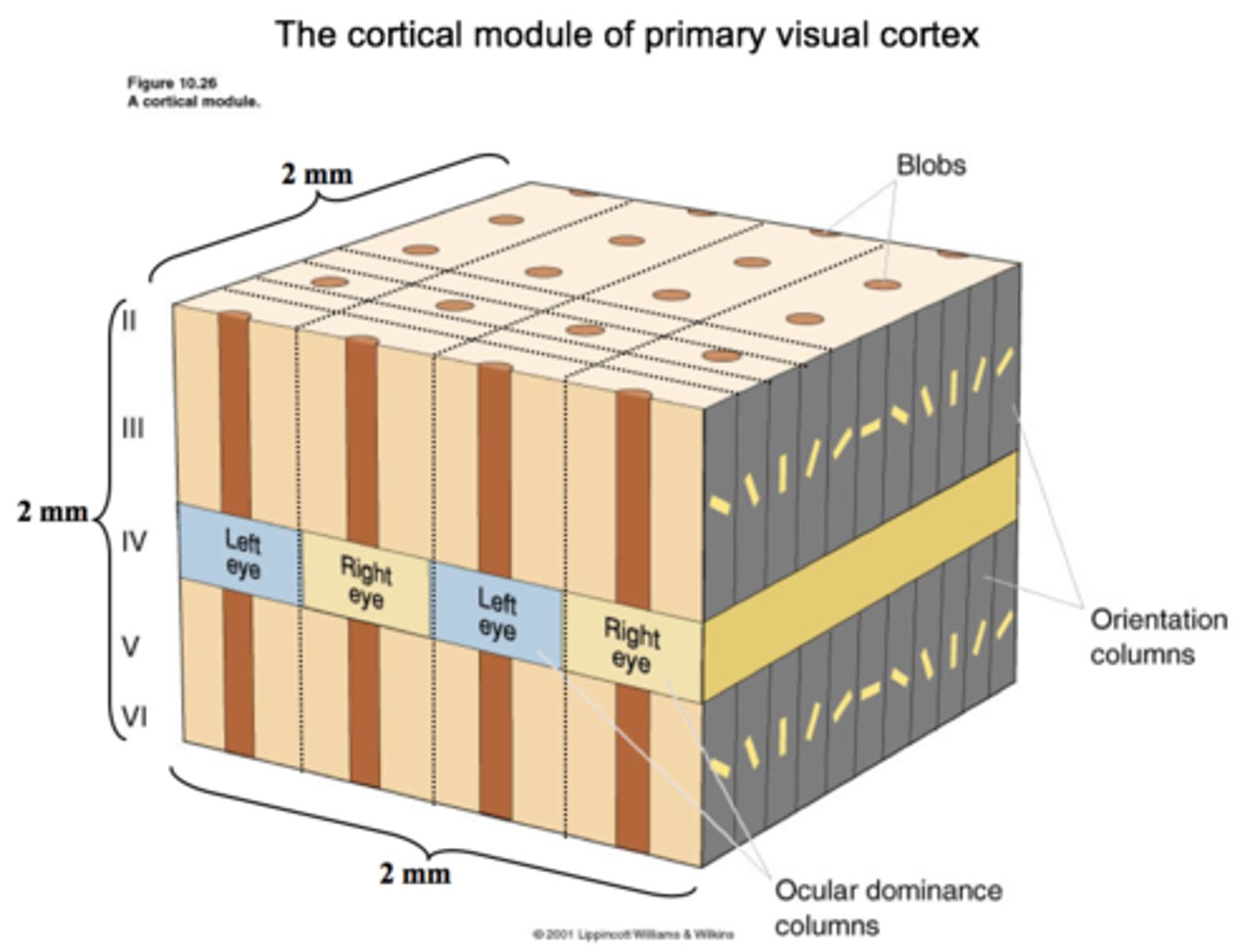
The neurons in the layers above and below layer 4C are driven by what?
The neurons in the layers above and below are driven by input from both eyes (i.e., the ipsilateral temporal hemiretina and contralateral nasal hemiretina), with the input from one hemiretina having a dominant influence.
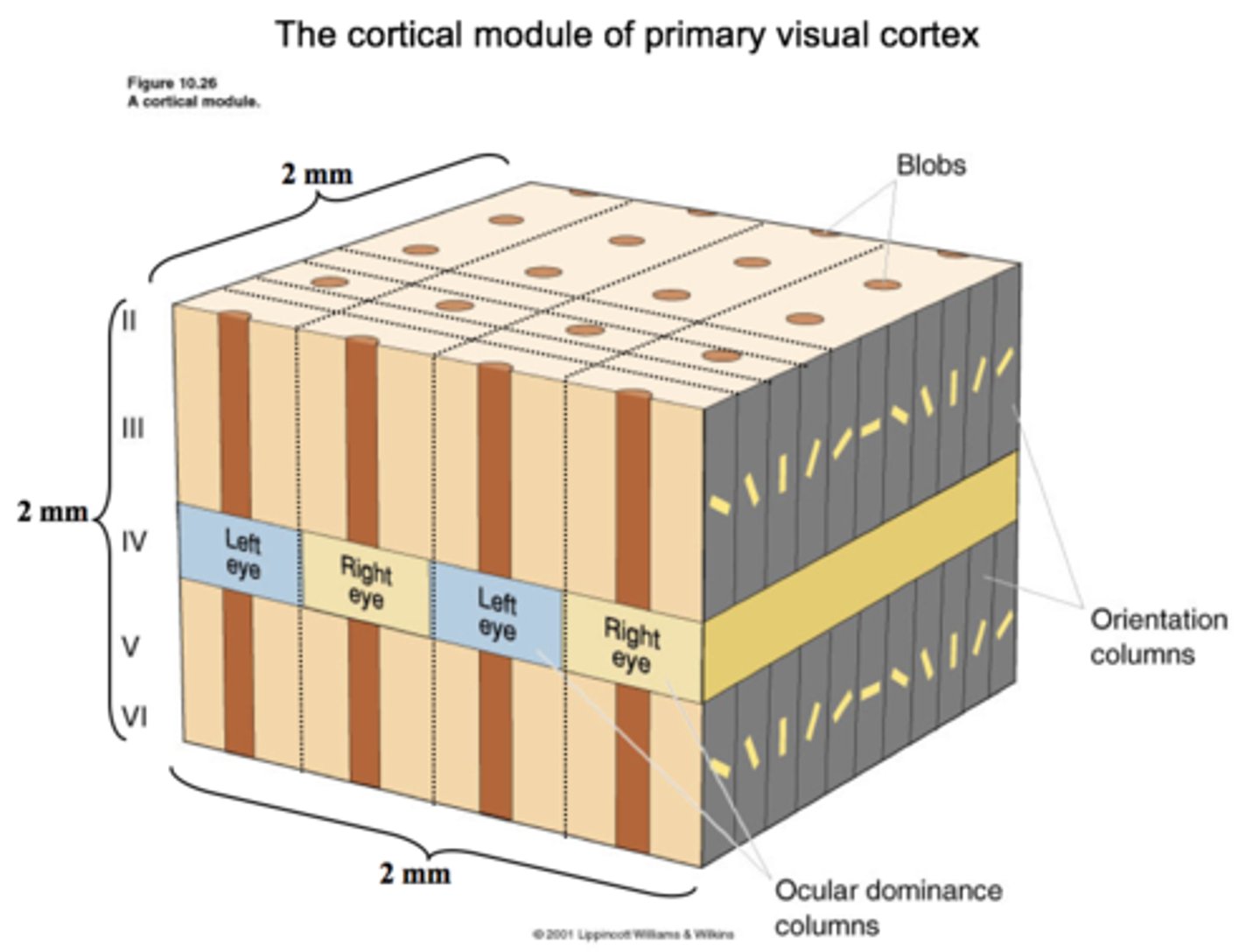
What are the cells in blobs sensitive and insensitive to?
Cells in blobs are color sensitive but insensitive to shape.
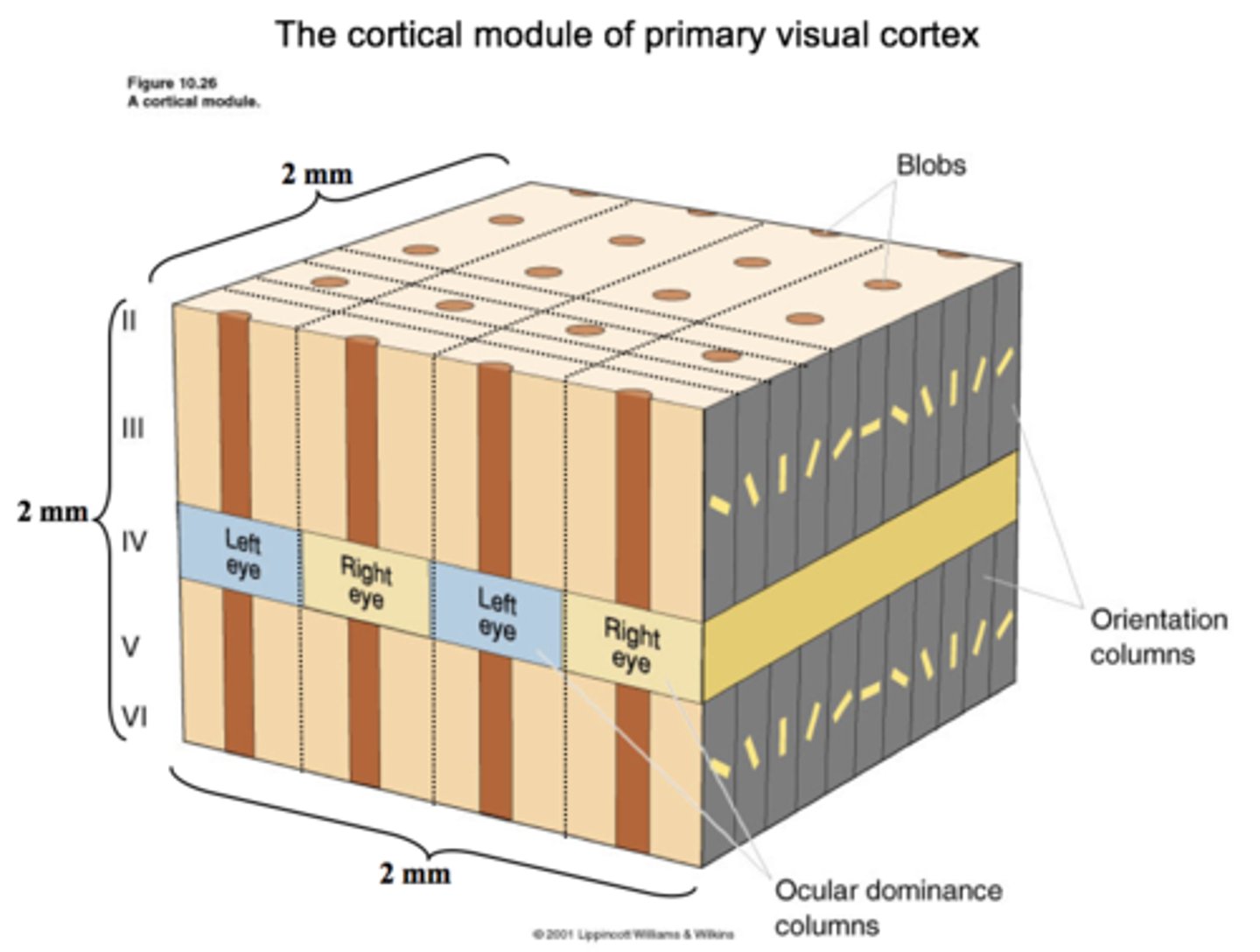
How many blobs are in each cortical module and where do the neurons project to?
There are 16 blobs in each cortical module, 4 per ocular dominance column. Neurons in Blobs project mainly to V4, which is specialized for color perception.

Where does information about the form of an object originate from and where does information about the color of an object arise from?
Information about the form of an object arises mostly from cells in the orientation column, and information about the color of an object arises mostly from cell in the blobs. Somehow this is integrated.
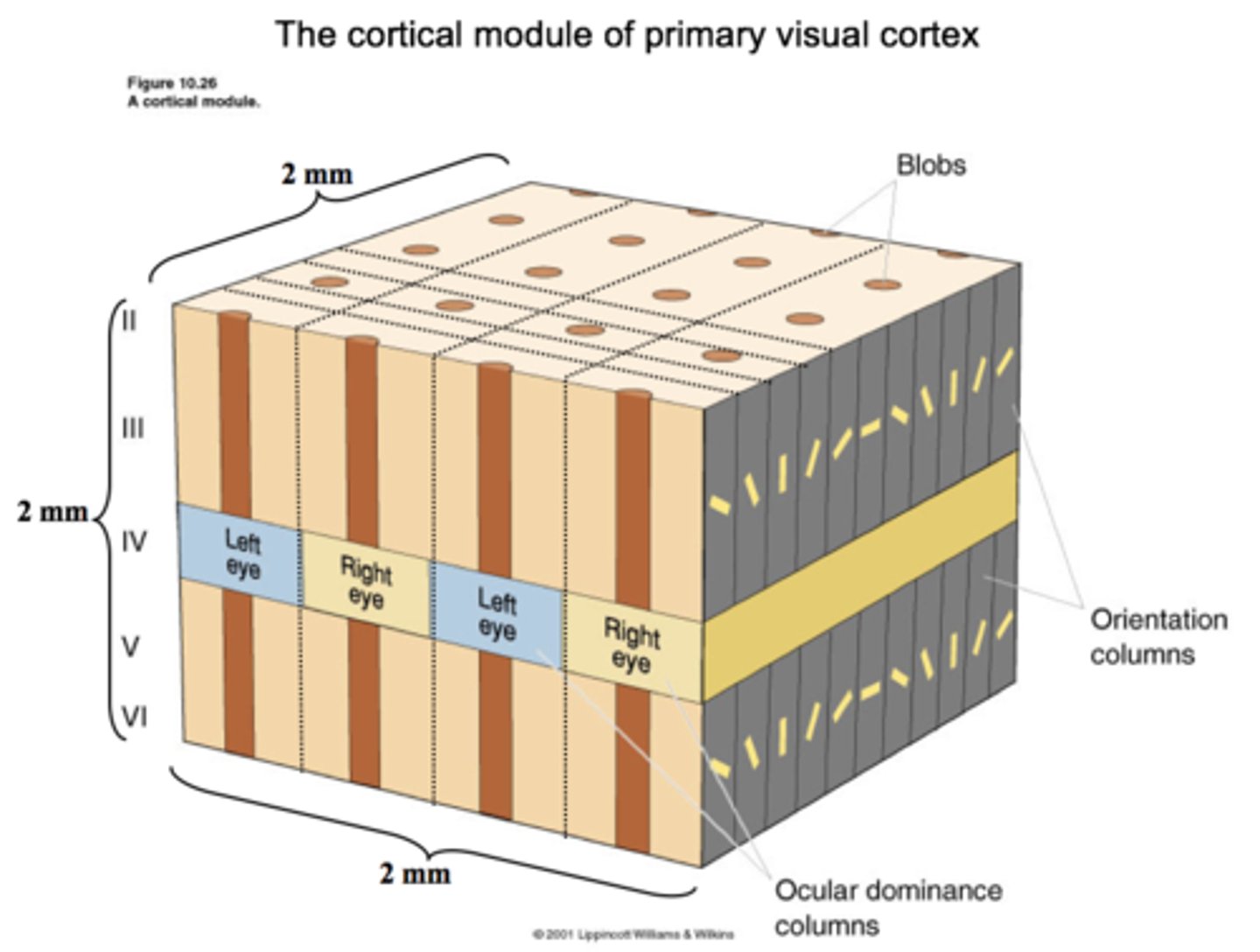
A diagram depicting a cortical module with neurons and the stimuli that drives them:
What drives the activity of neurons in an orientation column (i.e. what is their adequate stimulus?)
1. A spot of light or a spot of darkness will only weakly drive these neurons.
2. An elongated stimulus is what drives these neurons (a bar of light or dark of a particular orientation).
3. All the neurons in a particular orientation column respond to a line of the same particular orientation.
4. Neurons in adjacent orientation columns respond to lines with a 10 degree difference in rotation. Thus there is a progressive rotation of line orientation that drives these neurons as you move across the columns. If you record activity across all 36 orientation columns there will be a complete 360 degree rotation of the orientation of the "best stimulus."
5. Your perception on a visual stimulus is thought to depend upon which subsets of cells within the relevant cortical modules are active.
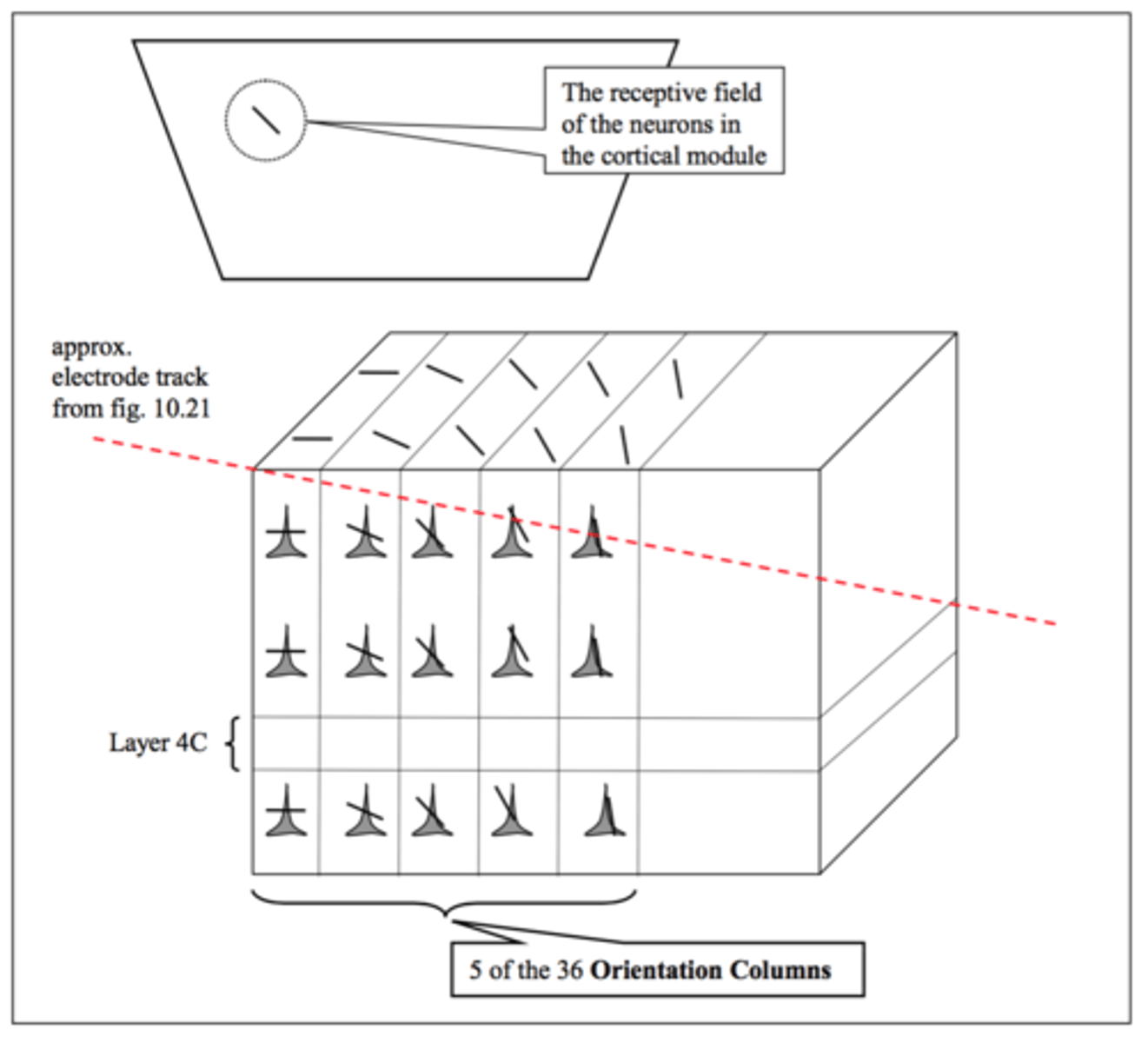
What will a spot of light or darkness do to these neurons?
A spot of light or a spot of darkness will only weakly drive these neurons.
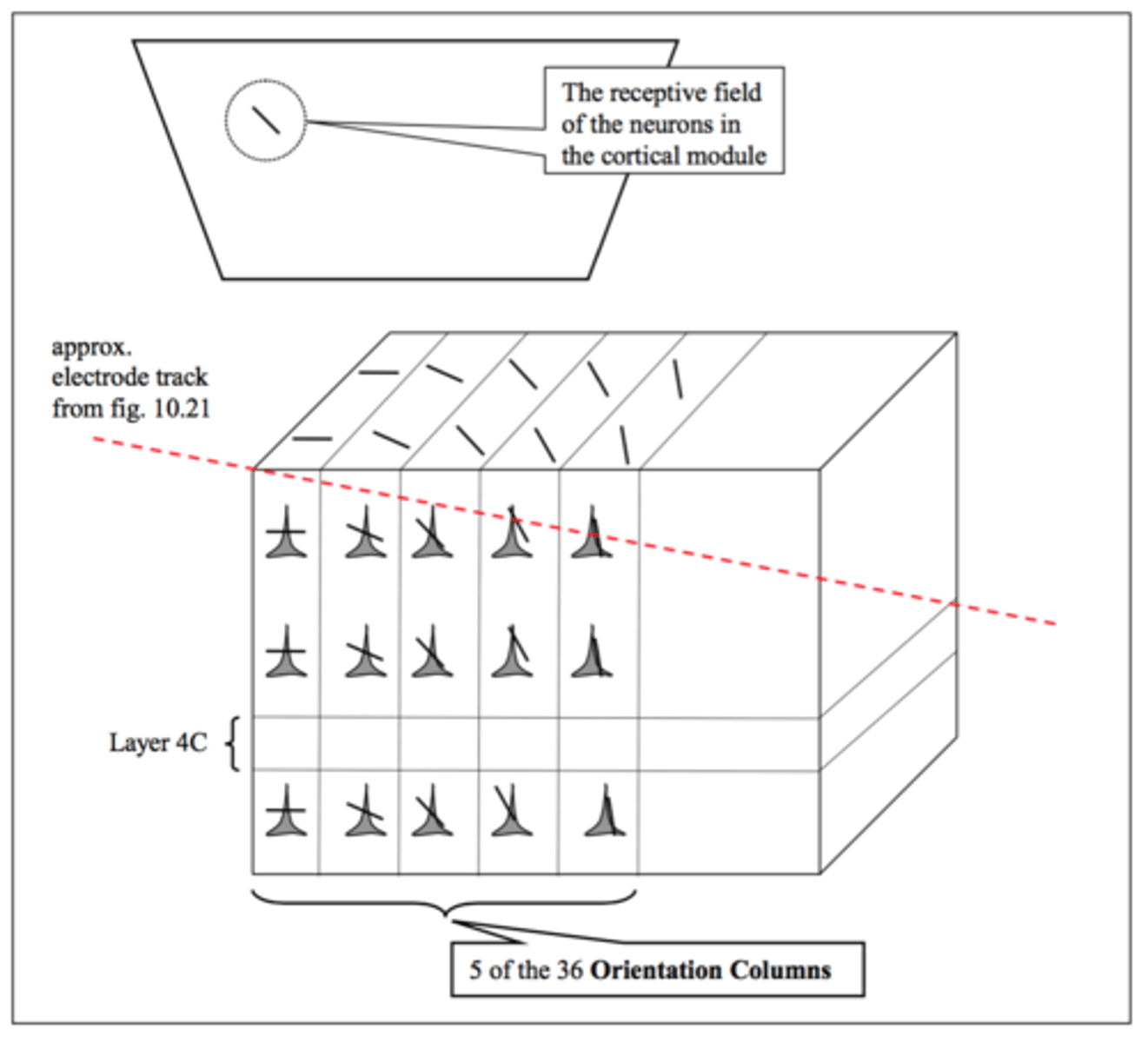
What drives these neurons?
An elongated stimulus is what drives these neurons (a bar of light or dark of a particular orientation).
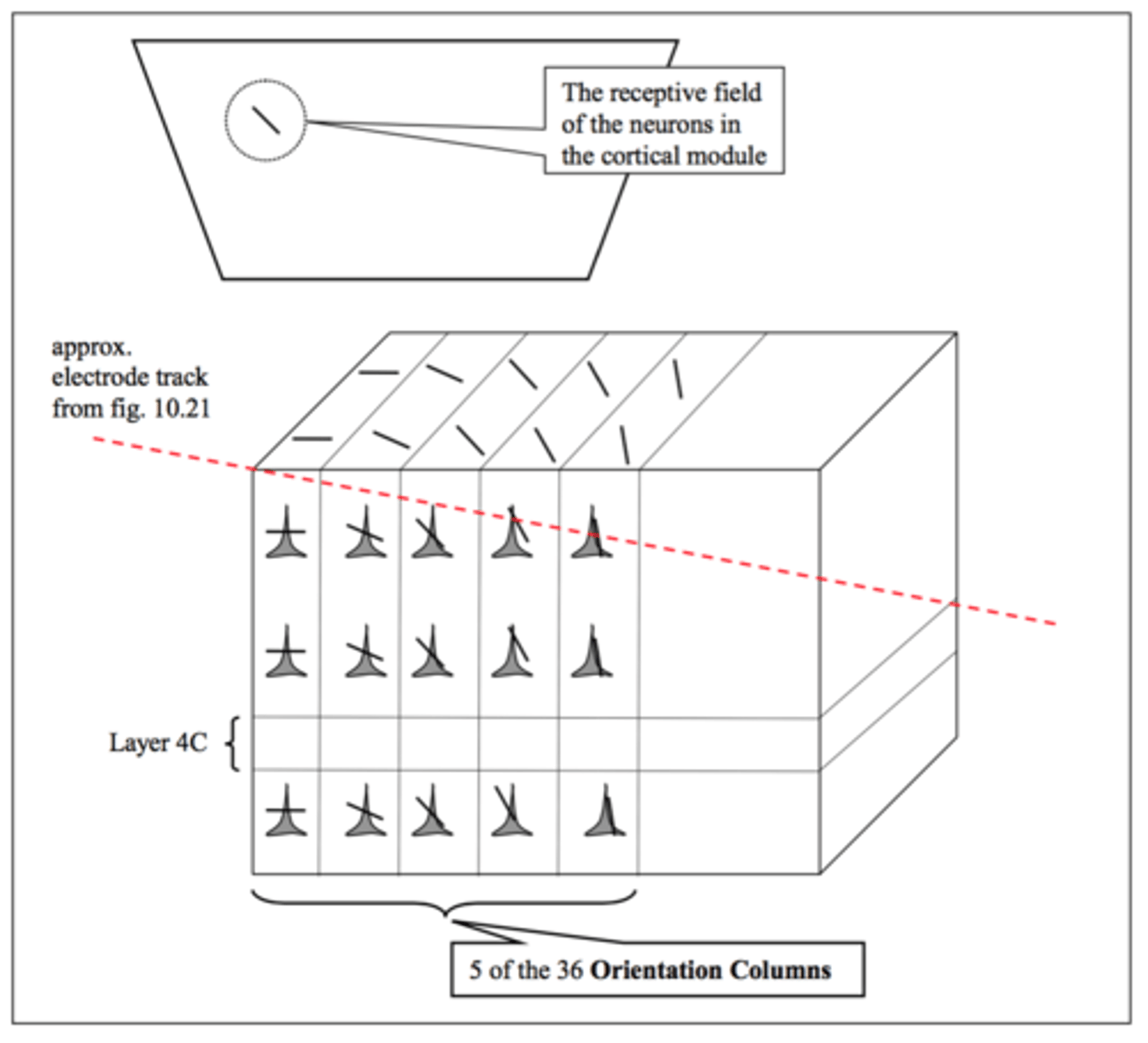
What do neurons in adjacent orientation columns respond to and what drives the neurons as you move across the columns?
Neurons in adjacent orientation columns respond to lines with a 10 degree difference in rotation. Thus there is a progressive rotation of line orientation that drives these neurons as you move across the columns. If you record activity across all 36 orientation columns there will be a complete 360 degree rotation of the orientation of the "best stimulus."
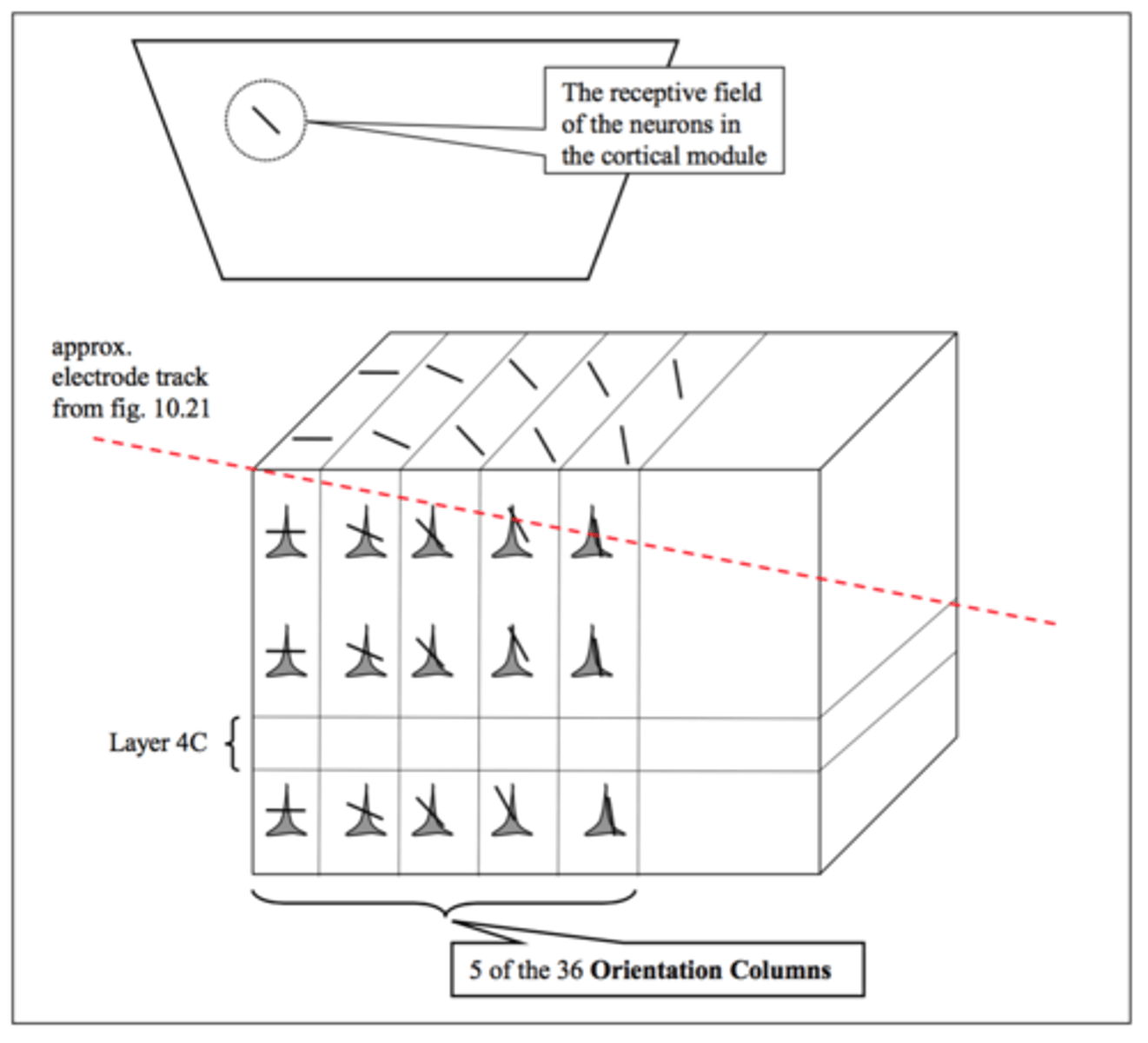
What is your perception on a visual stimulus thought to depend upon?
Your perception on a visual stimulus is thought to depend upon which subsets of cells within the relevant cortical modules are active.
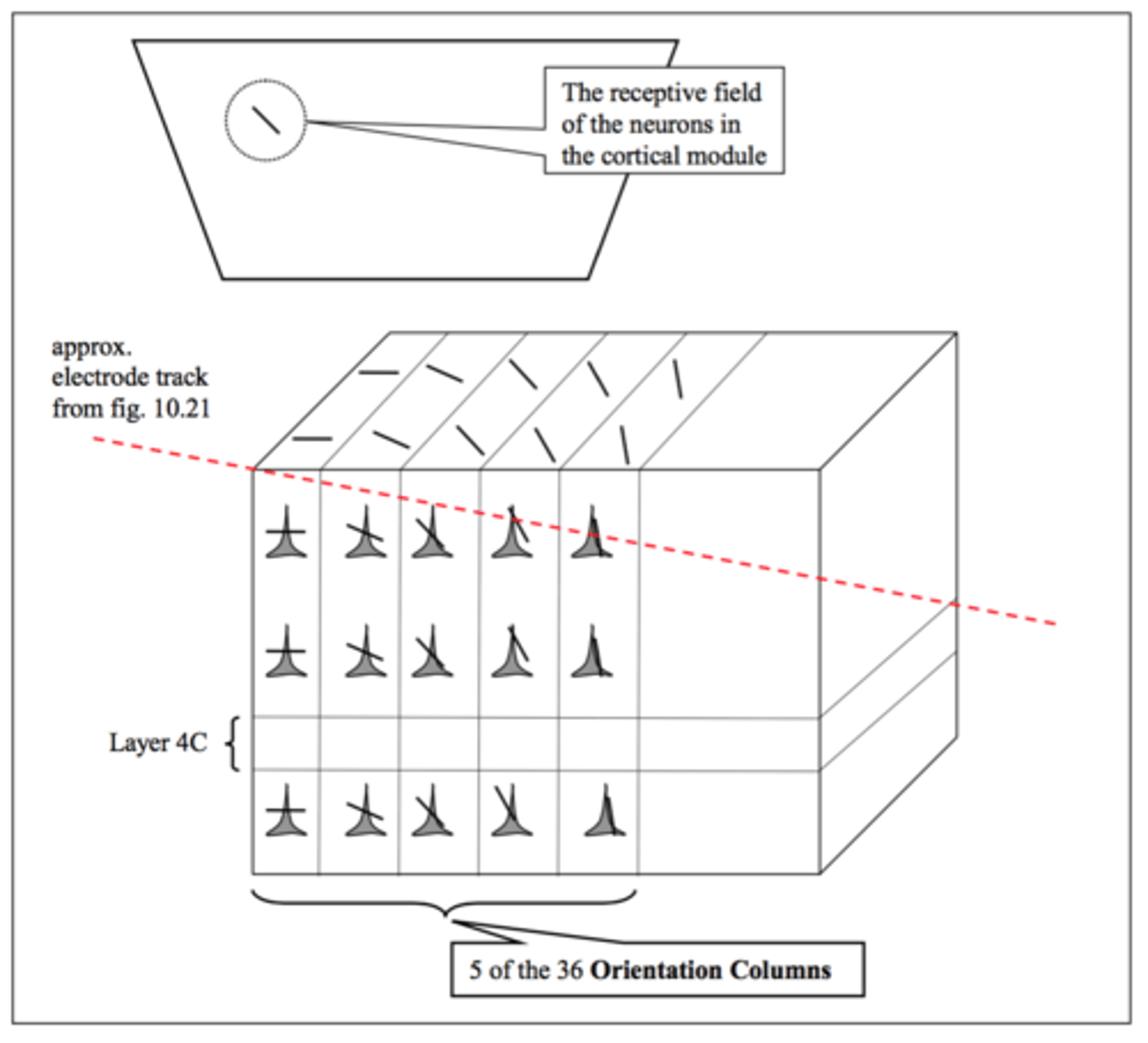
What are the mechanisms generating orientation columns?
1. Neurons in orientation columns have antagonistic center surround receptive fields, but they are not circular, rather they are elongated.
2. Below is a diagram of two so called "simple cell" receptive fields from two neurons in different orientation columns in V1 (they can be either on- or off-center). Also, see Figure 10.23.
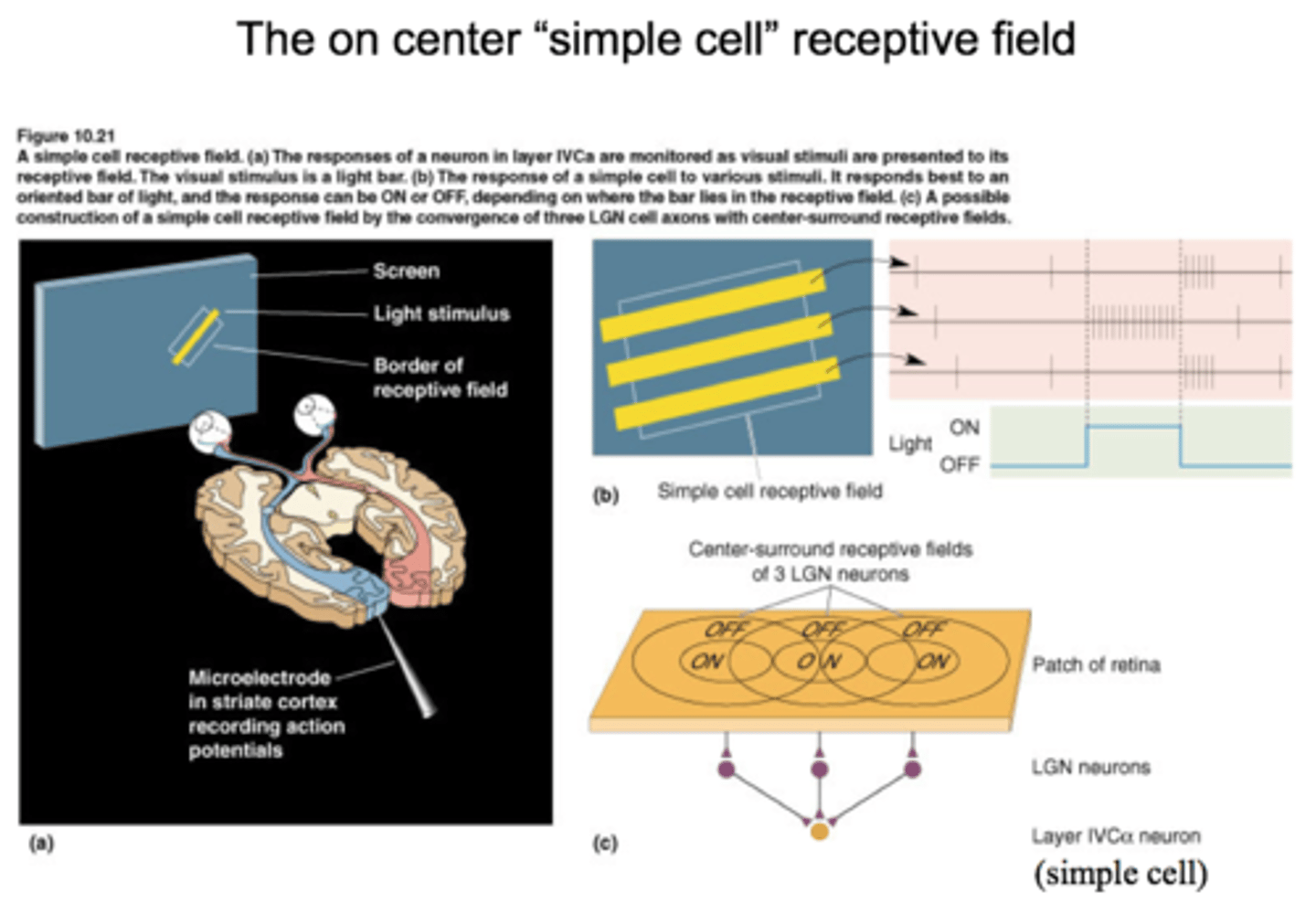
What type of receptive fields do neurons in orientation columns have?
Neurons in orientation columns have antagonistic center surround receptive fields, but they are not circular, rather they are elongated.
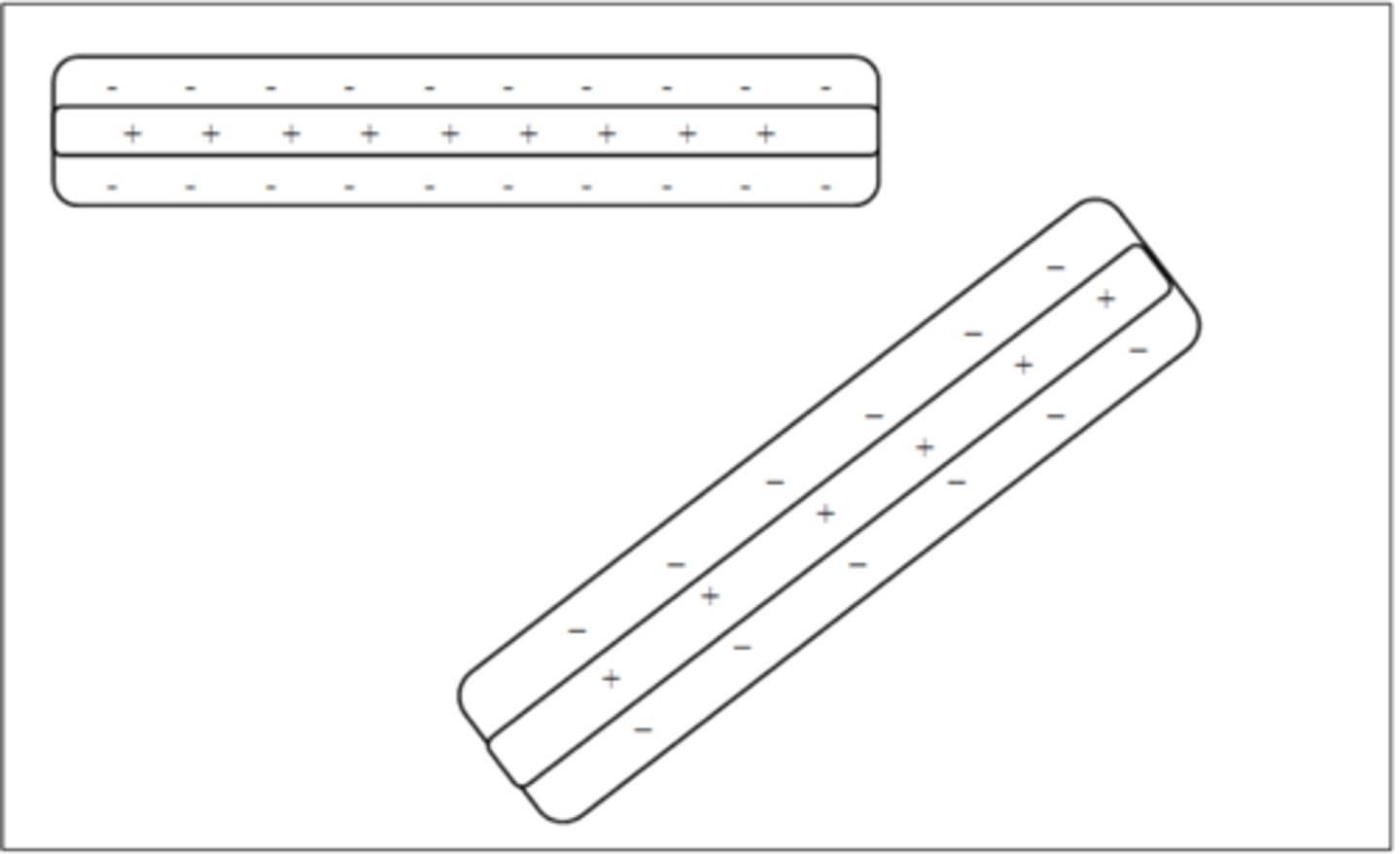
What are neurons in orientation columns the most sensitive to?
These neurons are most sensitive to bars that fill their center without impinging on the surround. They aren't sensitive to spots of light because spots don't fill much of the long center.
Why are these neurons sensitive to orientation of a bar of light?
They are sensitive to orientation because if the light stimulus isn't aligned with the receptive field center, then the light stimulus will fall on parts of both the center and the antagonistic surround.
What are the elongated receptive fields in orientation columns called?
This specific type of receptive field is called a "simple-cell" receptive field.
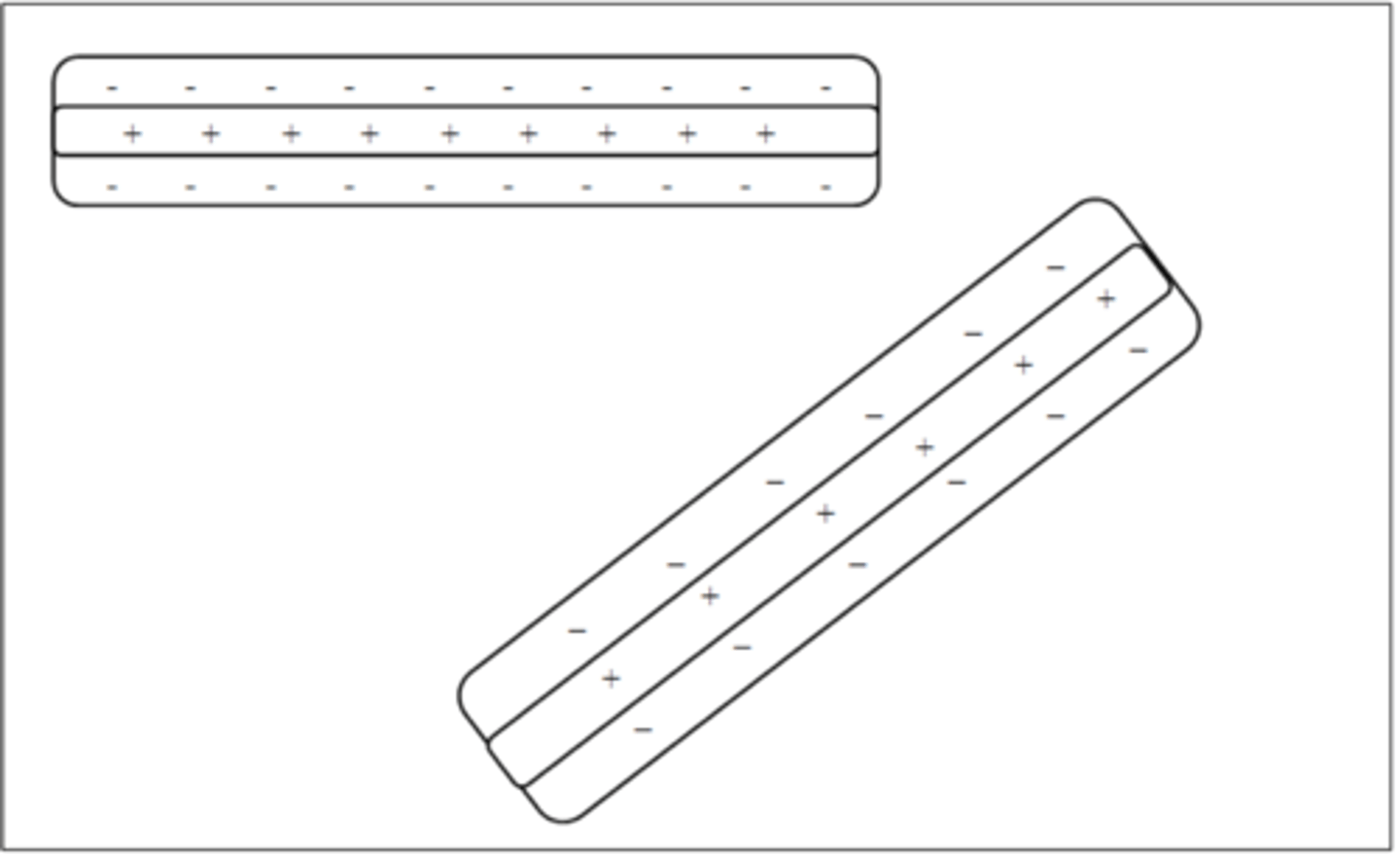
Where is the stimulus found in complex receptive fields?
There are also cells that have complex receptive fields, in which the stimulus can be anywhere within the receptive field, but it still must have a particular orientation. (Cells with simple receptive field response properties are most concentrated close to layer four in V1. Cells with "complex" receptive fields are most concentrated further above and below layer four and cells with even more complex receptive fields are concentrated even further above and below layer four).
How do these receptive fields arise?
They are believed to arise because these neurons receive highly organized patterns of input from neurons from the previous stage of processing. For example, a "simple cell" that specifically responds to a vertical bar of light is thought to receive inputs from a set of neurons each of which has a circular center-surround organization with the centers of the input neurons' receptive fields being aligned vertically with each other.
See Figure 10.23.
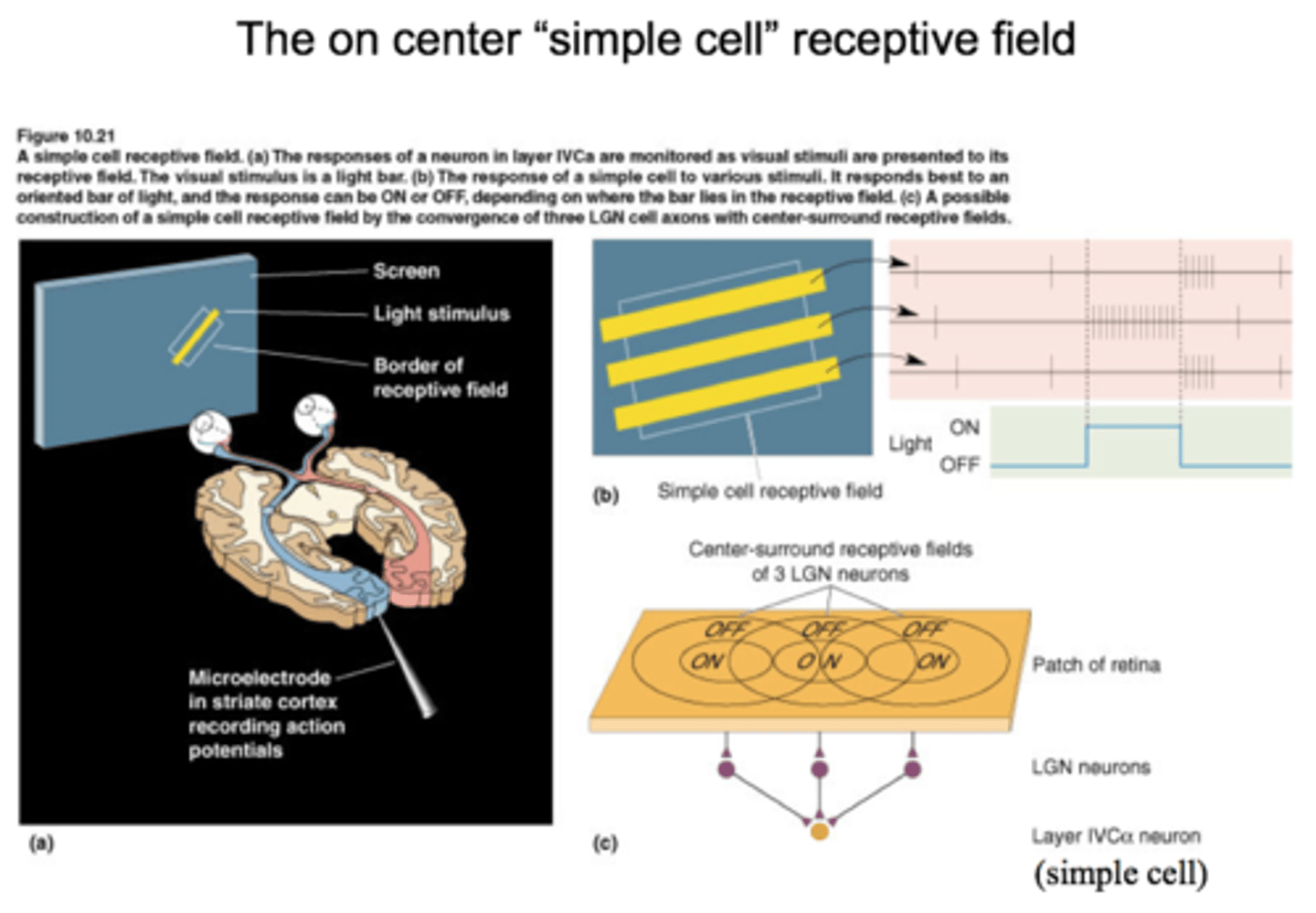
What does all this suggest?
All this suggests that the visual world is broken down into a mosaic, with each portion of the mosaic being analyzed by a different group of cells (one cortical module analyses one piece of the mosaic and the adjacent cortical module analyses an adjacent piece of the mosaic) and what we perceive is dependent upon which subset of neurons in each cortical module is active.
What type of processing happens in V1?
The processing of visual information in V1 is an intermediate level of processing. Now we go to a "later" stages, in inferotemporal ("ventral" stream - color and object recognition) and parietal cortex ("dorsal" stream, orientation and motion).
What does the IT cortex have and what does it do with it?
The IT cortex has subsets of neurons that respond selectively to highly complex visual stimuli (hands, faces, food, etc.)
Three questions to keep in mind
1. How do our perceptions of stimuli in different categories (hands vs. faces vs. chairs) arise?
2. How do we do this despite the fact that the image of the same object can be very different (open vs. closed book or frontal vs. profile view of a face)?
3. How do you recognize different individuals within a category (one book vs. another and one face vs. another)?